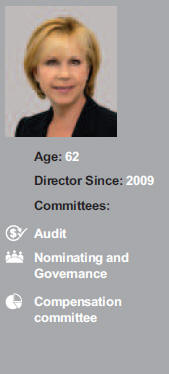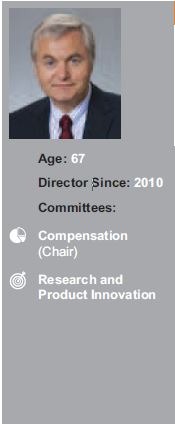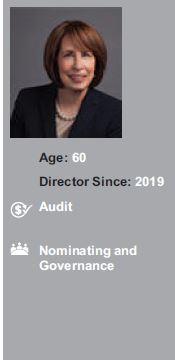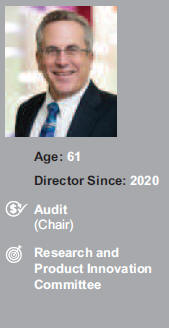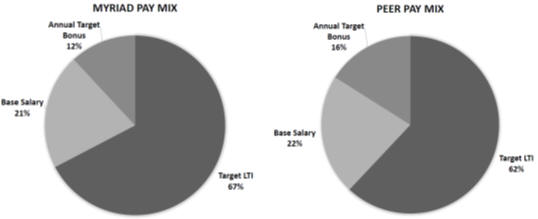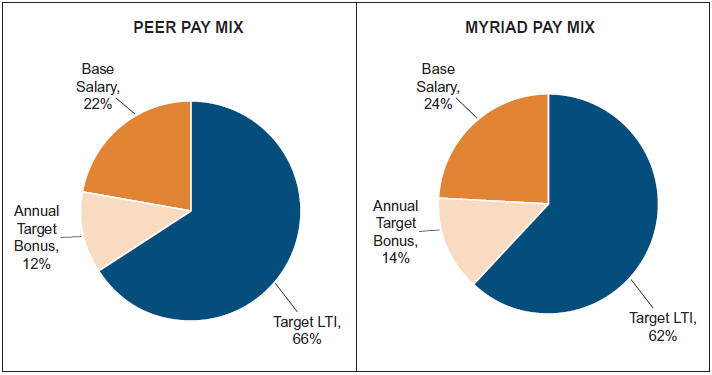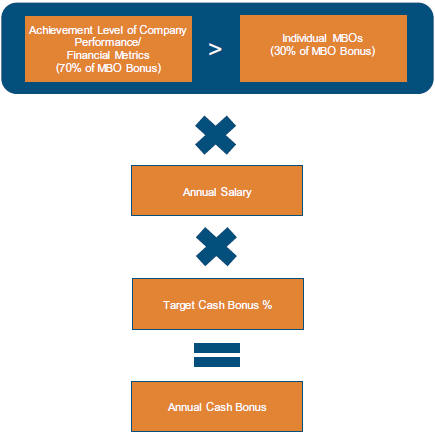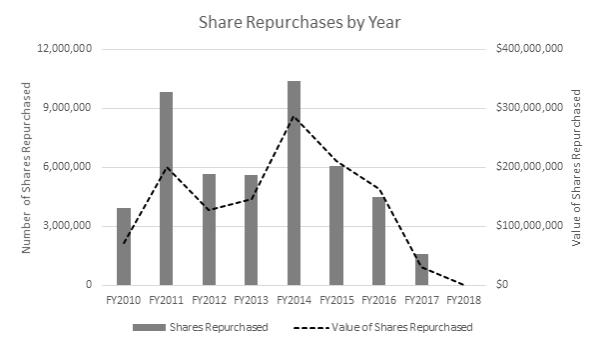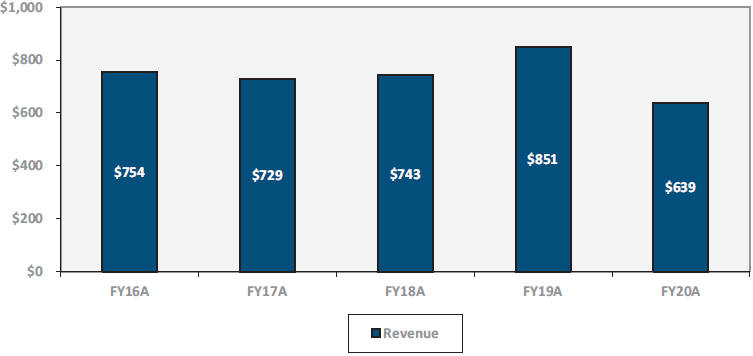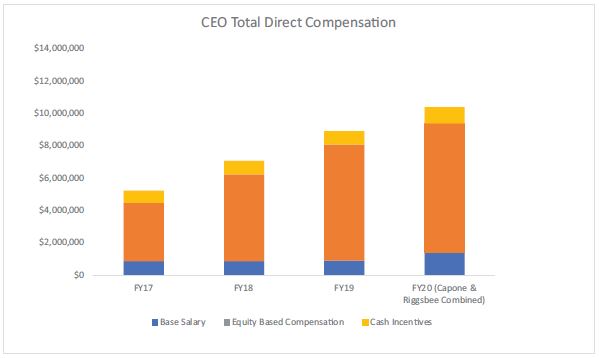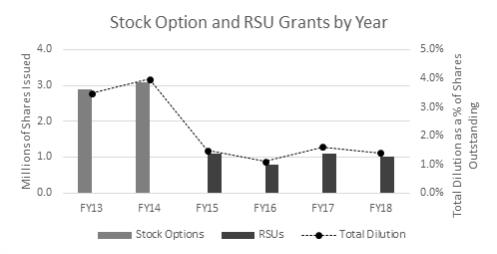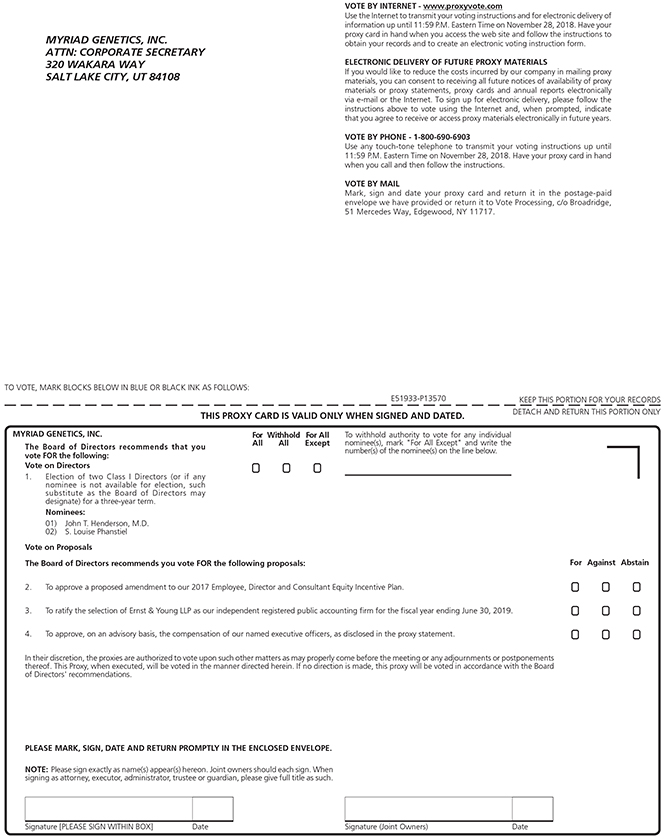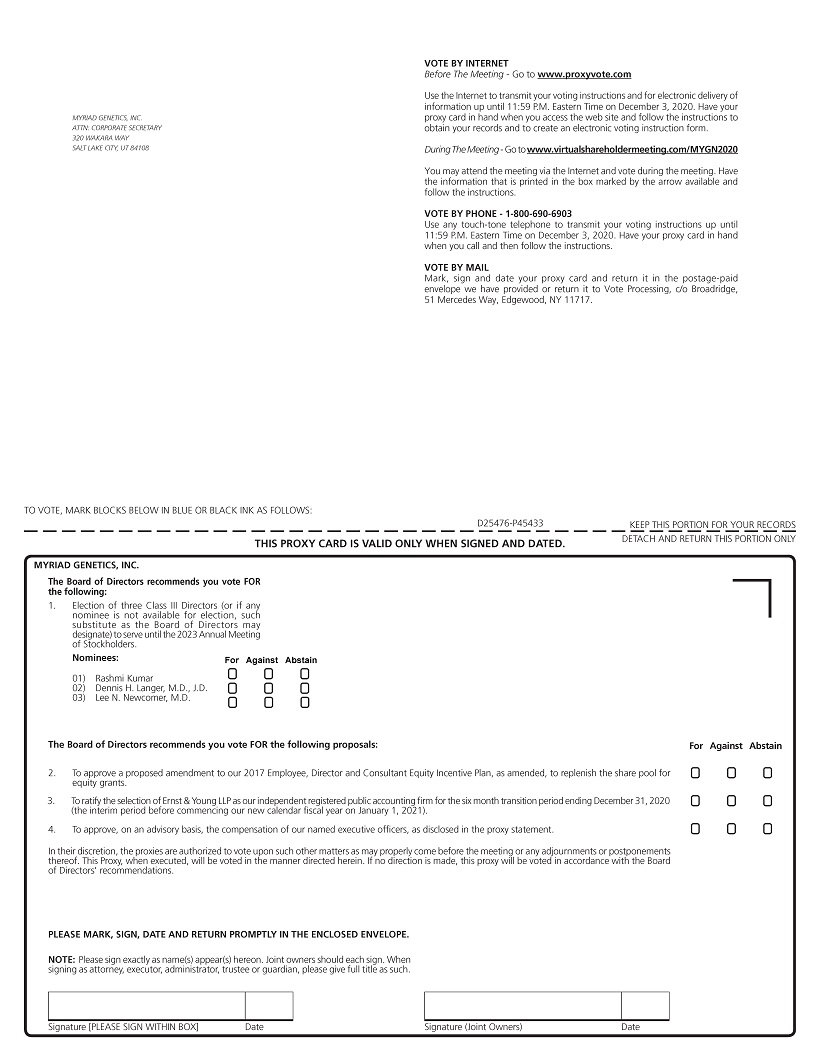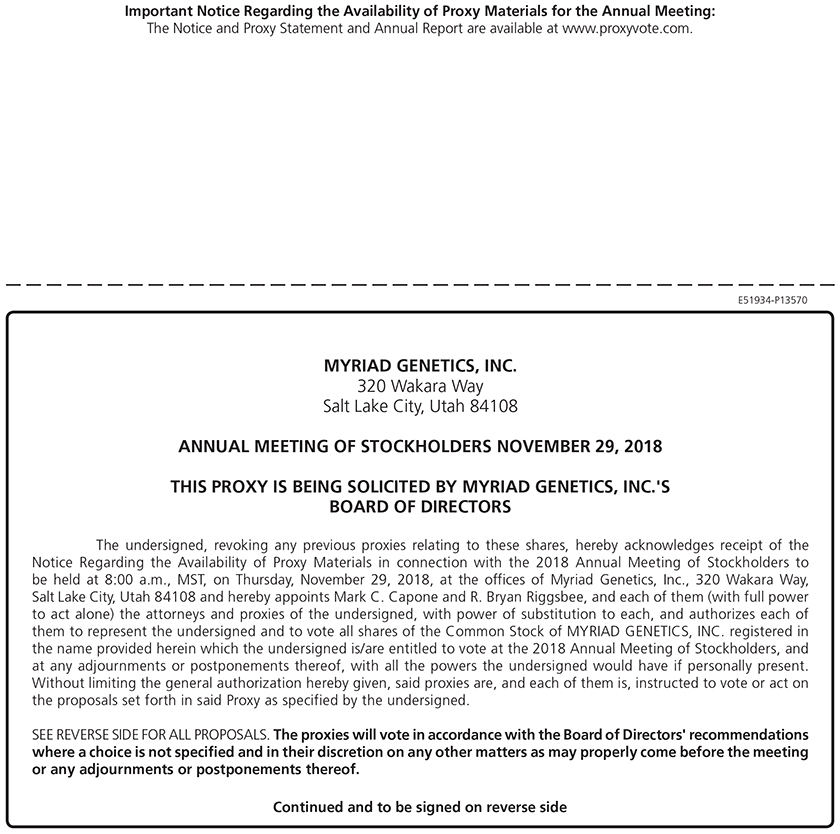|
MANAGEMENT AND CORPORATE GOVERNANCE |
| | | | | | | | | | | | | | | | |
|
DIRECTOR CAPABILITY MATRIX |
| | | | | | | | |
| | 
Board Diversity | | 
Financial | | 
Leadership | | 
Healthcare Industry | | 
Diagnostic Industry | | 
Research and Development | | 
Technology | | 
Public Company Governance |
| | | | | | | | |
S. Louise Phanstiel Chair of the Board | | ✓ | | ✓ | | ✓ | | ✓ | | | | | | | | ✓ |
| | | | | | | | |
Paul J. Diaz CEO | | ✓ | | ✓ | | ✓ | | ✓ | | | | | | | | ✓ |
| | | | | | | | |
Heiner Dreismann Ph.D. Director | | | 66 | | | Director✓ | | ✓ | | | | | | ✓ | | |
| | | | | | | | |
S. Louise Phanstiel (1) (3)Rashmi Kumar Director
| | ✓ | | | | ✓ | | | | | | ✓ | | | | |
| | | | | | | | |
Dennis Langer M.D., J.D. Director | | | 60 | ✓ | | ✓ | | ✓ | | ✓ | | ✓ | | | | ✓ |
| | | | | | | | |
Lee N. Newcomer M.D. Director | | | | | | ✓ | | ✓ | | ✓ | | ✓ | | | | |
| | | | | | | | |
Colleen F. Reitan Director | | ✓ | | ✓ | | ✓ | | ✓ | | | | | | ✓ | | |
| | | | | | | | |
Dan Skovronsky, M.D. Ph.D. Director | | | | | | ✓ | | ✓ | | ✓ | | ✓ | | | | |
| | | | | | | | |
Daniel K. Spiegelman Director | | | | ✓ | | ✓ | | ✓ | | | | | | | | ✓ |
(1) | Member of the Audit Committee.
|
(2) | Member of the Compensation Committee.
|
(3) | Member of the Nominating and Governance Committee.
|
(4) | Member of the Strategic Committee
|
The following is a brief summary of the background and business experience of each of our directors.
John T. Henderson, M.D., Chairman of the Board of Directors, has been a director of Myriad since May 2004 and Chairman of the Board since April 2005. Since December 2000, Dr. Henderson has served as a consultant to the pharmaceutical industry as President of Futurepharm LLC. Dr. Henderson currently serves on the Board of Directors of Cytokinetics, Inc. Until his retirement in December 2000, he was with Pfizer for over 25 years, most recently as a Vice
9
President in the Pfizer Pharmaceuticals Group. Dr. Henderson previously held vice presidential level positions with Pfizer in Research and Development in Europe and later in Japan. He also was Vice President, Medical for the Europe, U.S. and International Pharmaceuticals groups at Pfizer. He earned his bachelor’s and medical degrees from the University of Edinburgh and is a Fellow of the Royal College of Physicians (Ed.).
The Board of Directors has determined that Dr. Henderson should serve on the Board for the following reasons: His medical background provides the Board with expertise in developing predictive, personalized and prognostic testing services. Dr. Henderson provides the Board with business and management expertise from his senior positions at Pfizer for over 25 years, including expertise in research and development, which is critical to our development of molecular diagnostic testing services. He brings to the Board international experience as the Company implements strategies for international expansion.
Walter Gilbert, Ph.D., Vice Chairman of the Board of Directors, joined Myriad as a founding scientist and director in March 1992. Dr. Gilbert won the Nobel Prize in Chemistry in 1980 for his contributions to the development of DNA sequencing technology. He was a founder of Biogen, Inc. and its Chairman of the Board and Chief Executive Officer from 1981 to 1985. Dr. Gilbert has held professorships at Harvard University in the departments of Physics, Biophysics, Biology, Biochemistry and Molecular Biology, and Molecular and Cellular Biology. He is a Carl M. Loeb University Professor Emeritus at Harvard University. Dr. Gilbert founded and served on the Board of Directors of both Memory Pharmaceuticals Corp. and Paratek Pharmaceuticals, Inc. He also currently serves on the board of Amylyx Pharmaceuticals and is a General Partner of BioVentures Investors, an investment fund.
The Board of Directors has determined that Dr. Gilbert should serve on the Board for the following reasons: He provides the Board with a unique and extensive scientific background and expertise important to us in developing and commercializing molecular diagnostic products, and understanding technological developments in the industry. Dr. Gilbert provides the Board with business, managerial and financial expertise based on having founded, managed, and directed several companies in the healthcare industry.
Mark C. Capone, was appointed as the President and Chief Executive Officer, or CEO, of Myriad Genetics, Inc., and a member of the Board of Directors, effective July 1, 2015. Previously, he served as the President of Myriad Genetic Laboratories, Inc., a wholly owned subsidiary of Myriad. Mr. Capone joined the Company in October 2002, initially as Vice President of Sales until being named Chief Operating Officer in February 2006, a position he held until his promotion to President of Myriad Genetic Laboratories, Inc. in March 2010. Prior to joining Myriad, he served 17 years with Eli Lilly and Company, where he held positions as Product Development Manager, Manufacturing Plant Manager, and Area Sales Director. Mr. Capone received his B.S. degree in Chemical Engineering from Penn State University, graduating with highest distinction, his M.S. degree in Chemical Engineering from the Massachusetts Institute of Technology, and his M.S. in Management from the Massachusetts Institute of Technology.
The Board of Directors has determined that Mr. Capone should serve on the Board for the following reasons: He provides the Board with business and management expertise at a molecular diagnostic company from his 14 years of service as President, Chief Operating Officer and Vice President of Sales at Myriad Genetic Laboratories. Mr. Capone brings to the Board additional experience in operations management, product development, finance, sales, and other operational areas from his experience at Eli Lilly and Company. He also provides us with important expertise in investor relations based on his past interactions with our investor base. Additionally, Mr. Capone’s scientific, engineering and business management background and education provide important insights for the Board.
Lawrence C. Best, a director of Myriad since September 2009, is the Chairman and Founder of OXO Capital LLC, an investment firm focused on life sciences and therapeutic medical device companies, since 2007. He joined Boston Scientific Corporation in 1992 and served for 15 years as the Executive Vice President-Finance & Administration and Chief Financial Officer. Prior to joining Boston Scientific, Mr. Best was a partner in the accounting firm of Ernst & Young, where he specialized in serving multinational companies in the high technology and life sciences fields. He served atwo-year fellowship at the SEC from 1979 to 1981 and aone-year term as a White House-
10
appointed Presidential Exchange Executive in Washington, D.C. He is a founding director of the President’s Council at Massachusetts General Hospital. Within the past five years Mr. Best also has served on the Board of Directors of Haemonetics Corp, Biogen, Inc. and as Executive Chairman of Cardiovalve Ltd., a privately held medical device company based in Tel Aviv, Israel. He received a B.B.A. degree from Kent State University.
The Board of Directors has determined that Mr. Best should serve on the Board for the following reasons: He provides the Board with broad financial accounting and reporting expertise in the technology and life sciences fields. Mr. Best provides extensive financial, business, management and investment expertise from his 15 years of service as the Chief Financial Officer at Boston Scientific. He also provides the Board with substantial experience in the event of potential mergers, acquisitions and licensing opportunities.
Heiner Dreismann, Ph.D., a director of Myriad since June 2010, had a successful career at the Roche Group from 1985 to 2006 where he held several senior positions, including President and CEO of Roche Molecular Systems, Head of Global Business Development for Roche Diagnostics and member of Roche’s Global Diagnostic Executive Committee. From 2006 to 2009, Dr. Dreismann served as the CEO of Vectrant Technologies, Inc., and until 2013 was the Interim CEO for GeneNews Limited. During the past five years, Dr. Dreismann served on the Board of Directors of Med BioGene, Inc., Genenews Limited, Interpace Diagnostics and Ignyta, Inc.. He earned a M.S. degree in biology and his Ph.D. in microbiology/molecular biology (summa cum laude) from Westfaelische Wilhelms University (The University of Münster) in Germany.
The Board of Directors has determined that Dr. Dreismann should serve on the Board for the following reasons: He provides the Board with important business and managerial expertise from his more than 20 years at Roche, including specific expertise in developing and commercially launching diagnostic products. Furthermore, Dr. Dreismann has extensive experience in international markets, specifically in Europe, while he was CEO of Roche Molecular Systems, the international leader in molecular diagnostics, which is important as we seek to expand internationally. His scientific background and expertise also enable him to provide the Board with technical advice on product research and development. Dr. Dreismann has a diversified background in managing and serving as a director of several companies in the healthcare industry.
Dennis H. Langer, M.D., J.D., has been a director of Myriad since May 2004. From January 2013 to July 2014 he served as Chairman and Chief Executive Officer of AdvanDx, Inc. From August 2005 to May 2010, Dr. Langer served as Managing Partner of Phoenix IP Ventures, LLC. From January 2004 to July 2005, he was President, North America for Dr. Reddy’s Laboratories, Inc. From September 1994 until January 2004, Dr. Langer held several high-level positions at GlaxoSmithKline, and its predecessor, SmithKline Beecham, including most recently as a Senior Vice President of Research and Development. He has a broad base of experience in innovative R&D companies such as Eli Lilly, Abbott and Searle. He is also a clinical professor at the Department of Psychiatry, Georgetown University School of Medicine. Dr. Langer received a J.D. from Harvard Law School, an M.D. from Georgetown University School of Medicine, and a B.A. in Biology from Columbia University. He currently serves on the Board of Directors of Dicerna Pharmaceuticals, Inc. and Pernix Therapeutics Holdings, Inc. During the past five years, Dr. Langer served on the Board of Delcath Systems, Inc.
The Board of Directors has determined that Dr. Langer should serve on the Board for the following reasons: His medical background provides the Board with expertise in developing predictive, personalized, and prognostic testing products. Dr. Langer provides the Board with business and management expertise from senior positions at several major pharmaceutical companies, including expertise in research and development, which is critical to our development of molecular diagnostic testing services. He brings international experience as we implement strategies for global expansion. Dr. Langer’s background as a board certified psychiatrist and a clinical professor of psychiatry with extensive experience in neuropsychiatric drug development and personalized medicine provides the Board with expertise in developing and commercializing diagnostics to help physicians determine the right medications for patients suffering from neuropsychiatric and other medical conditions. Dr. Langer also has a diversified background in managing and serving as a director of several companies in the healthcare industry.
11
S. Louise Phanstiel, a director of Myriad since September 2009, held several important positions at WellPoint, Inc. from 1996 to 2007, including as President, Specialty Products (2003 to 2007), Senior Vice President, Chief of Staff and Corporate Planning in the Office of the Chairman (2000 to 2003), and Senior Vice President, Chief Accounting Officer, Controller, and Chief Financial Officer for all WellPoint, Inc. subsidiaries, including Blue Cross of California (1996 to 2000). Previously, Ms. Phanstiel was a partner at the international services firm of Coopers & Lybrand where she served clients in life and property/casualty insurance, high technology, and higher education. She currently serves on the Board of Directors of Verastem, Inc. and the Stony Brook Foundation. Ms. Phanstiel received a B.A. degree in Accounting from Golden Gate University and is a Certified Public Accountant.
The Board of Directors has determined that Ms. Phanstiel should serve on the Board for the following reasons: She provides the Board with important expertise on the medical insurance industry based on her extensive experience in several senior positions at WellPoint and Blue Cross of California. This expertise is critical as we rely on third-party reimbursement for our molecular diagnostic services. Ms. Phanstiel also provides the Board with financial accounting and reporting expertise from her work at Coopers & Lybrand and as a Certified Public Accountant. In addition, she provides the Board with financial and investment expertise, as well as management expertise, resulting from managing and serving as a director of publicly-traded companies.
Director Independence
Our Board of Directors has reviewed the materiality of any relationship that each of our directors has with Myriad, either directly or indirectly. Based on this review, the Board has determined that the following members of the Board are “independent directors”‘‘independent directors’’ as defined by The NASDAQNasdaq Stock Market LLC:LLC ‘‘Nasdaq’’: Mr. Best, Dr. Dreismann, Dr. Gilbert, Dr. Henderson, Ms. Kumar, Dr. Langer, Dr. Newcomer, Ms. Phanstiel, Ms. Reitan, Dr. Skovronsky, and Ms. Phanstiel.Mr. Spiegelman.
Leadership Structure of the Board
The Board does not have a policy regarding the separation of the roles of ChairmanChair of the Board and Chief Executive Officer because the Board believes that it is in our best interests to make that determination based on the position and direction of the Company and the membership of the Board. However, at this time, and since our inception, the Board has determined that having an independent director serve as ChairmanChair of the Board is in the best interests of our stockholders. Thus, the roles of ChairmanChair of the Board and Chief Executive Officer are separated. This structure enables a greater role for the independent directors in the oversight of the Company and their active participation in setting agendas and establishing Board policies, priorities and procedures. This structure also allows the Chief Executive Officer to focus on the management of ourday-to-day operations.
Board’s Role in the Oversight of Risk Management
The Board has an active role, directly and through its committees, in the oversight of our risk management efforts. The Board carries out this oversight role through several levels of review. It regularly reviews and discusses with members of management information regarding the management of risks inherent in the operations of our businesses and the implementation of our strategic plan, including our risk mitigation efforts.
| | |

| | 21 |


























